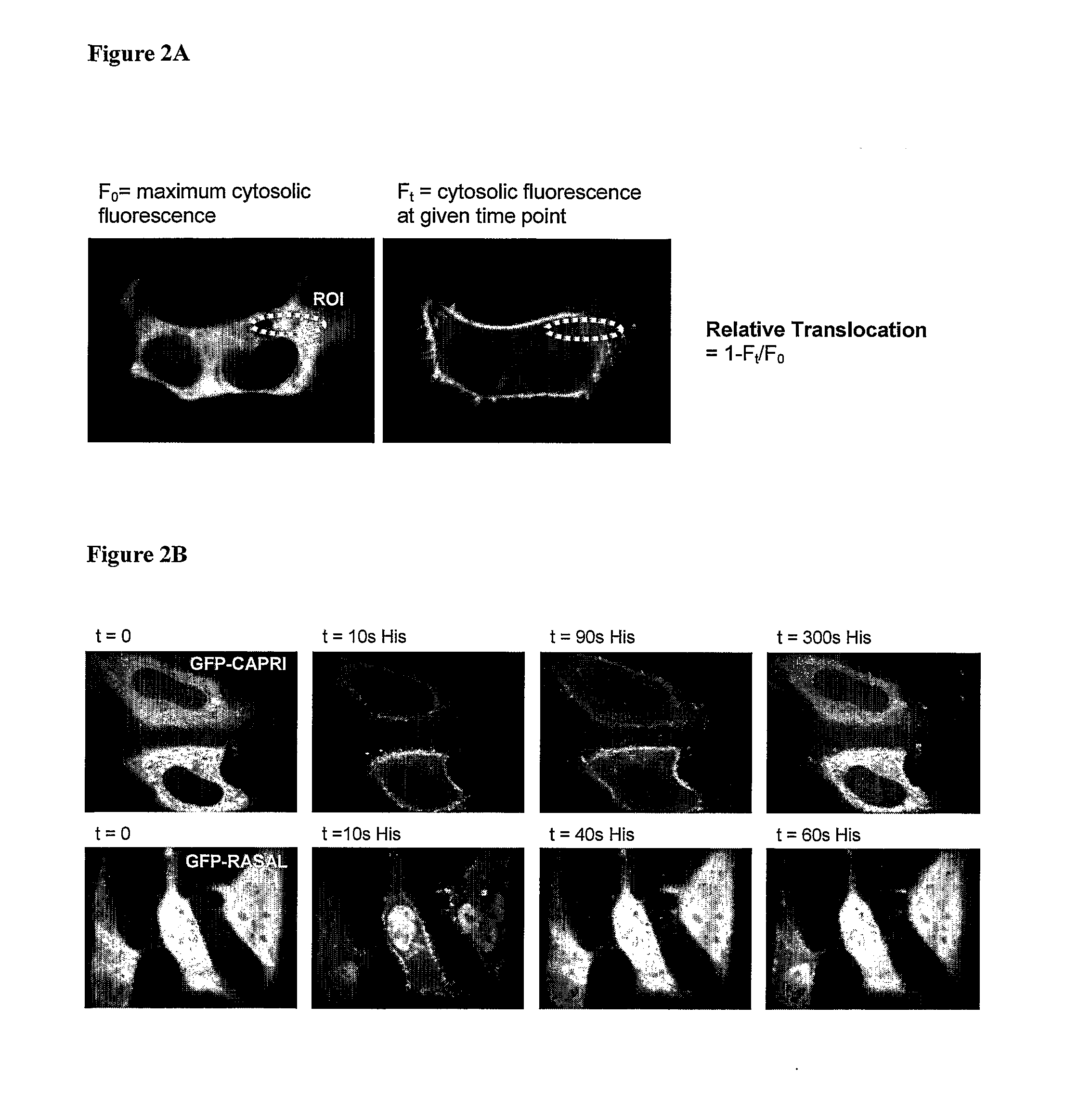Methods For Detecting Calcium Ion Influx
- Summary
- Abstract
- Description
- Claims
- Application Information
AI Technical Summary
Benefits of technology
Problems solved by technology
Method used
Image
Examples
example 1
Ca2+ Influx Assay Using a Genetically-Encoded Fluorescent Reporter—Translocation of CAPRI and RASAL in Response to Agonist (100 μM Histamine) Stimulation of HeLa Cells
[0161]The day before transfection HeLa cells were seeded onto 22 mm glass coverslips in 6-well tissue culture dishes at such a density to reach 60-80% confluence within 24 hours. The following day (approximately 24 hours later) HeLa cells were transfected with green fluorescent protein GFP-CAPRI or GFP-RASAL using GeneJuice Transfection Reagent (Merck) according to the manufacturers instructions.
[0162]After 24 hrs incubation in transfection mix (complete media plus transfection reagent) at 37° C., 5% CO2) coverslips were transferred to holders containing 2 ml of KH buffer (10 mM HEPES, 118 mM NaCl, 4.7 mM KCl, 10 mM glucose, 1.2 mM KH2PO4, 4.2 mM NaHCO3, 1.2 mM CaCl2, pH 7.4) and monitoring performed by live imaging in a 37° C. heated chamber on an inverted Nikon TE-2000 microscope using a 40× oil objective lens. Indiv...
example 2
Screening to Detect a Receptor Antagonist Compound
[0170]The day before transfection COS-7, HEK293 and HeLa cells are seeded onto 22 mm glass coverslips in 6-well tissue culture dishes at such a density to reach 60-80% confluence within 24 hours. After approximately 24 hours, COS-7, HEK293 and HeLa cells are transiently transfected with GFP-CAPRI plasmid DNA using Lipofectamine (GIBCO BRL) or GeneJuice transfection reagent (Merck) according to manufacturers instructions and incubated for 24 hours as above. The cells are incubated with test compound in EM buffer (121 mM NaCl, 5.4 mM KCl, 1.6 mM MgCl2, 6 mM NaHCO3, 9 mM glucose, 1.3 mM CaCl2, 25 mM HEPES, pH 7.4) or KH buffer (10 mM HEPES, 118 mM NaCl, 4.7 mM KCl, 10 mM glucose, 1.2 mM KH2PO4, 4.2 mM NaHCO3, 1.2 mM CaCl2, pH 7.4) for up to one hour.
[0171]To stimulate calcium influx, the agonist histamine (HeLa; 1-100 μM)) or ATP (HeLa, HEK293 and COS; 50 μM) is applied by bulk addition (rapid mixing of 5 ml of agonist in appropriate im...
example 3
Screening for SOCE Channel Inhibitors
[0174]The day before transfection COS-7, HEK293 and HeLa cells are seeded onto 22 mm glass coverslips in 6-well tissue culture dishes at such a density to reach 60-80% confluence within 24 hours. After approximately 24 hours, COS-7, HEK293 and HeLa cells are transiently transfected with GFP-CAPRI plasmid DNA using Lipofectamine (GIBCO BRL) or GeneJuice transfection reagent (Merck) according to manufacturers instructions and incubated for 24 hours as above.
[0175]Prior to introduction of the test compound, cells are stimulated with 1-5 μM thapsigargin in 2 ml Ca2+-free media for 5 minutes. The cells are then incubated in the presence of the test compound for up to one hour.
[0176]The cells are imaged in Ca2+-free EM buffer (121 mM NaCl, 5.4 mM KCl, 1.6 mM MgCl2, 6 mM NaHCO3, 9 mM glucose, 0.5 mM EGTA, 25 mM HEPES, pH 7.4) or Ca2+-free KH buffer (10 mM HEPES, 118 mM NaCl, 4.7 mM KCl, 10 mM glucose, 1.2 mM KH2PO4, 4.2 mM NaHCO3, 0.5 mM EGTA, pH 7.4). ...
PUM
| Property | Measurement | Unit |
|---|---|---|
| Fluorescence | aaaaa | aaaaa |
Abstract
Description
Claims
Application Information
 Login to View More
Login to View More - R&D
- Intellectual Property
- Life Sciences
- Materials
- Tech Scout
- Unparalleled Data Quality
- Higher Quality Content
- 60% Fewer Hallucinations
Browse by: Latest US Patents, China's latest patents, Technical Efficacy Thesaurus, Application Domain, Technology Topic, Popular Technical Reports.
© 2025 PatSnap. All rights reserved.Legal|Privacy policy|Modern Slavery Act Transparency Statement|Sitemap|About US| Contact US: help@patsnap.com



